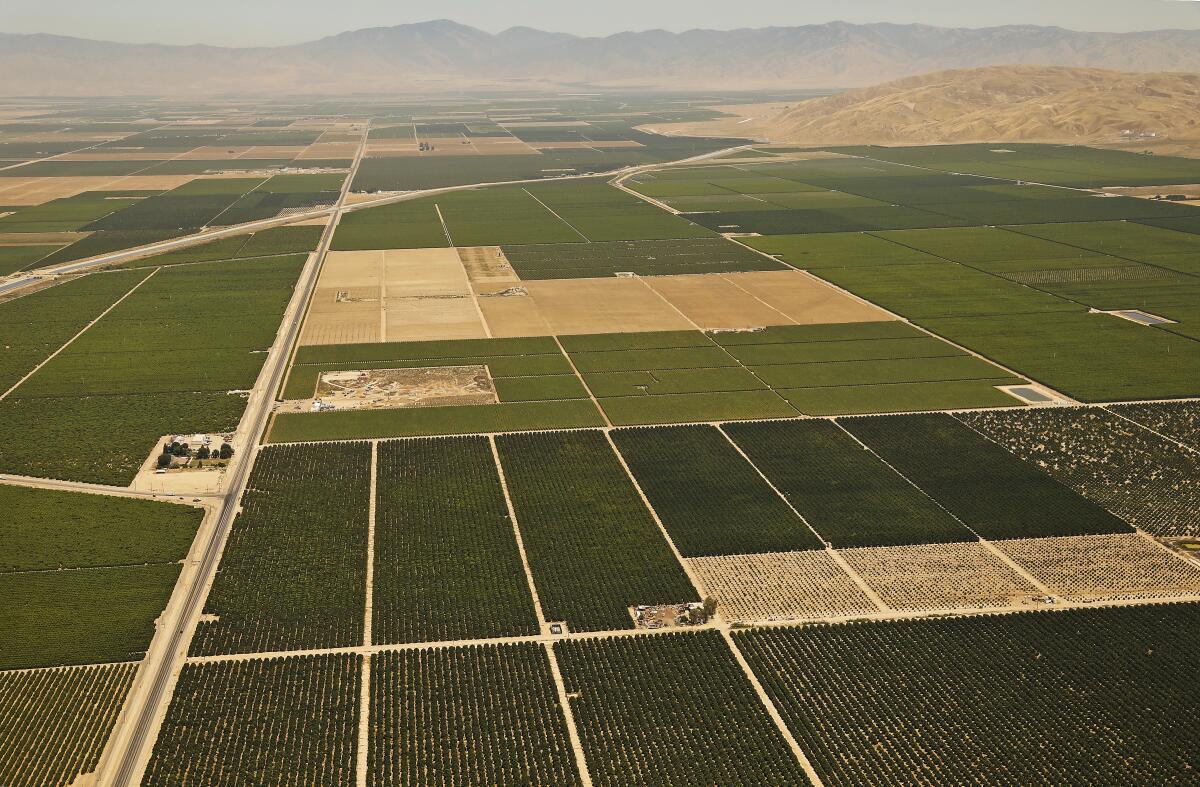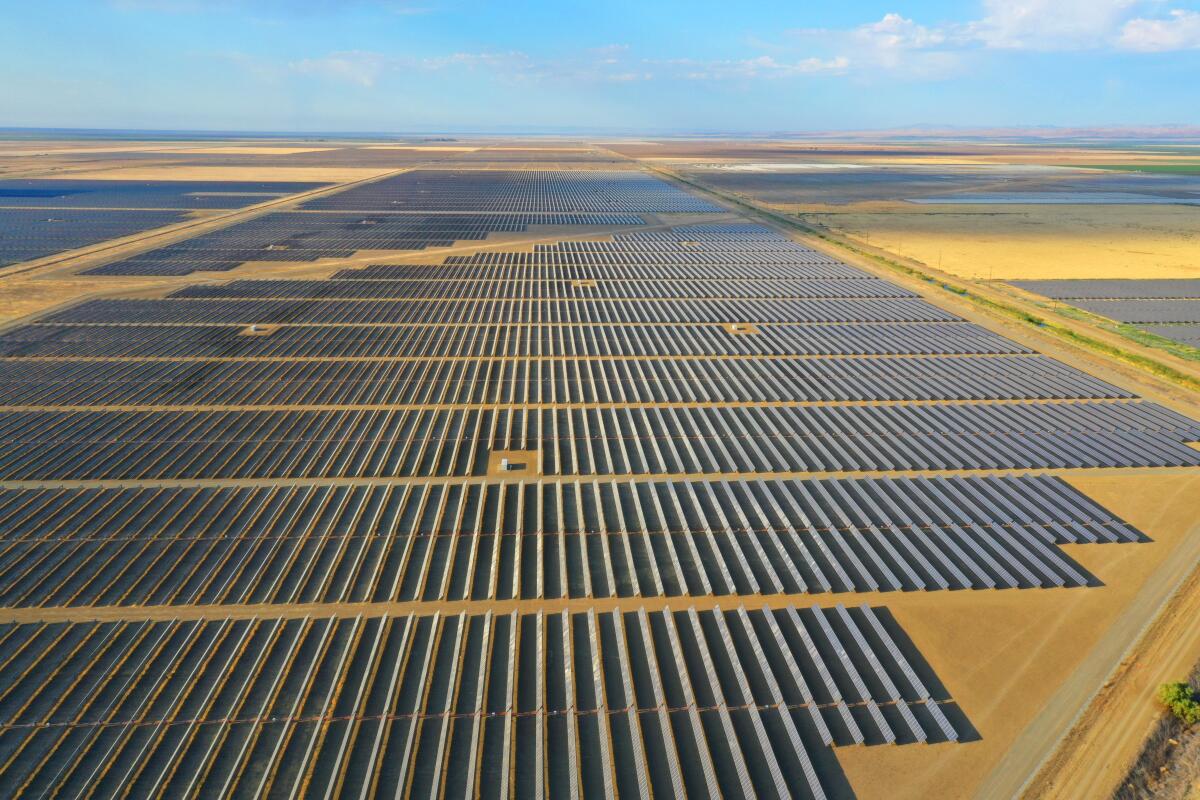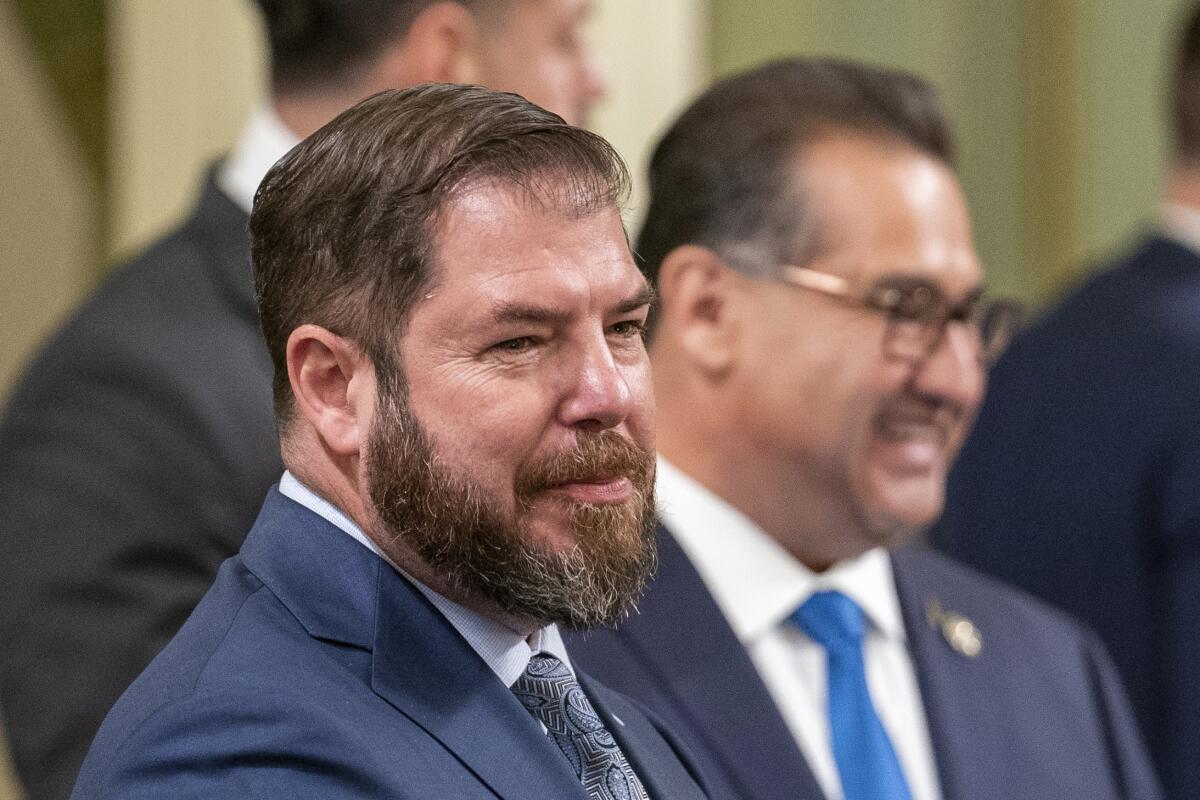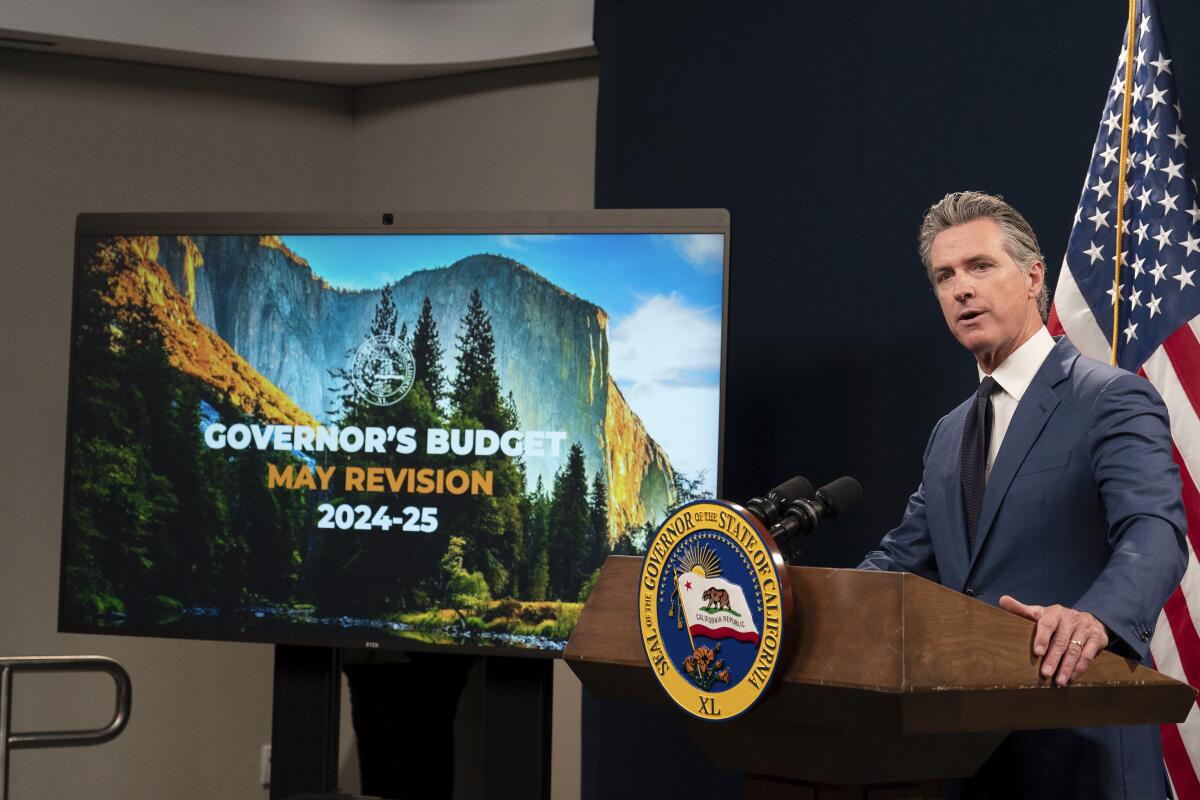Column: California farmers are low on water. Why not help them go solar?

- Share via
It sounds like a climate solution everyone should be able to support: Let’s make it easier and cheaper for farmers with dwindling water supplies to convert their lands from crop production to solar energy generation, if that’s what those farmers want.
So why did the California Legislature just reject such a bill?
“Change can be difficult,” said Shannon Eddy, executive director of the Large-scale Solar Assn.
Tell me about it.
You're reading Boiling Point
Sammy Roth gets you up to speed on climate change, energy and the environment. Sign up to get it in your inbox twice a week.
You may occasionally receive promotional content from the Los Angeles Times.
Even as coal, oil and gas combustion fuel an ever-deadlier rise in global temperatures, finding a spot to build a solar or wind farm where no one will object is damn near impossible. Some concerns are legitimate, such as safeguarding wildlife habitat and sacred Indigenous sites. Others, not so much. Take, for example, false claims that living near renewable energy projects can cause health problems — claims that have been spread by groups with ties to the fossil fuel industry, and by former President Trump.
The misinformation campaigns, unfortunately, aren’t going anywhere.
But in the American West — where pristine landscapes are treasured, and dry times are getting drier with climate change — the region’s abundant agricultural lands seem like a great place to put solar panels while minimizing environmental conflicts.
In California in particular, groundwater levels have fallen dramatically after decades of overpumping, especially by Central Valley farmers. Global warming, meanwhile, is sapping the river flows that also supply large amounts of water to agribusinesses.
So it’s no surprise that a growing number of farmers are converting some of their fields to solar.
“In one case we’re growing an agricultural product that has value, and in another case we’re producing electrons that have value,” Steven Swartz, an executive at Wonderful Co., the company owned by billionaires Stewart and Lynda Resnick, told me in 2019.
For some farmers, though, there’s a financial obstacle: the Williamson Act.

Also known as the California Land Conservation Act of 1965, the law gives property tax breaks to landowners who sign contracts agreeing to keep their land in agricultural production or open space for at least 10 years. Landowners who make those deals are taxed based on the value of their land for what it’s currently being used for (i.e. farming), rather than the full market value of the land (which would be a lot higher, since the landowner could otherwise sell to a residential or commercial developer).
The Williamson Act’s goal — as explained to me by Chris Scheuring, senior counsel for California Farm Bureau Federation — was to preserve farms and ranches as property values rose in the 1950s and 1960s, sending suburbs sprawling in all directions.
The law has had climate benefits too: Keeping new housing more tightly packed in cities can limit long freeway commutes. Plus, “working lands” such as farms and ranches can be useful for absorbing heat-trapping carbon emissions if handled with care.
“The Williamson Act is an important statute. It’s a successful statue,” Scheuring said.
The challenge can arise if a grower wants to switch from vegetables, nuts or other crops to solar energy.
To get out of a Williamson Act agreement, a landowner typically must wait out the 10-year contract or pay an upfront fee — often 12.5% of their land’s full market value, to account for the fact that they’ve benefited from years of reduced tax payments.
That makes sense in a nutshell.
But here’s the thing: We’re in a desperate hurry to stave off the worsening heat waves, floods and fires of the climate crisis. And under the state groundwater law, there will almost certainly be huge amounts of farmland fallowed in the San Joaquin Valley.
So why not tweak the Williamson Act to make it cheaper for those growers to switch to solar?
That was the idea behind Assembly Bill 2528 from Assemblymember Joaquin Arambula (D-Fresno).
Here’s how it would have worked: In eight San Joaquin Valley counties with groundwater basins that state officials consider to be in “critical overdraft,” landowners could have asked local politicians to cancel their Williamson Act contracts for a fee of just 6.25%, half the normal rate, if they wanted to use their properties for solar farms, wind turbines or batteries — or transmission lines that hook up to renewable energy projects. A portion of the fees would have paid for local “community benefits packages.”
Arambula told me the Williamson Act has proved especially challenging for landowners who want to go solar because the 10-year contracts renew every year unless a farmer decides to cancel — a process that takes a decade, or else that hefty upfront fee.
“This bill allows us to begin to site and build these solar projects sooner,” he said.

The legislation cleared the Assembly’s utilities and agriculture committees with no dissenting votes, powered by supporters that included solar developers, agriculture industry groups and unions whose members build solar and wind farms.
But on Thursday, the legislation was “held” by the Assembly’s appropriation’s committee — a mysterious maneuver that offers little public transparency, and which makes it unlikely the bill will advance this year. A spokesperson for Assemblymember Buffy Wicks (D-Oakland), the chairperson, had no comment on why Wicks held this particular bill.
Divisions within the agricultural community may help explain why.
One major backer was the Irvine-based Western Growers Assn. Matthew Allen, the group’s vice president of state government affairs, told me it was crucial that the legislation left final decision-making to local governments. If a county board of supervisors decided it didn’t want to see farmland converted from crop production to solar generation, it would have been allowed to say no.
“The county is essentially in charge,” Allen said.
Although nobody voted against the bill at first, a few Democrats declined to vote “yes.” To help overcome skepticism, Arambula watered down the original bill, which would have zeroed out cancellation fees entirely for solar farm conversions. He also limited the bill to the San Joaquin Valley, to avoid confrontations with some lawmakers in other agricultural regions.
Alas, thus far it’s all been for naught — at least partly because of opposition from the farm bureau.
When I asked Scheuring why the farm bureau opposed AB 2528, he told me California has some of the world’s most fertile soil — and there’s only so much of it. Once a landowner goes solar, he said, their farm ground may never be the same.
“If we pave it over, there it goes,” he said.
The group’s opposition runs deeper than that, though.
As I learned during a visit to the Imperial Valley, another agricultural empire in California’s southeastern corner, some growers — like many of us — simply don’t like change. These are folks whose families have enjoyed quiet, agrarian existences for a century or more (even if their workers haven’t always had it so good). So when industrial solar projects move in next door, many farmers see the developers as a threat to their way of life — even as their neighbors eagerly sell their land or take lease payments.
Scheuring assured me the farm bureau isn’t opposed to solar, and I believe him. He also said he’s sympathetic to family farmers who don’t feel confident they’ll have enough water to keep investing in growing crops. I believe him on that front, too.
When I asked him what would be so bad about making it as easy as possible for growers in water-stressed areas to get out of their Williamson Act contracts, he responded that “getting out of the Williamson Act was not intended to be as easy as possible.” If we want to protect farmland and open space, he said, we should protect farmland and open space. Don’t weaken the law.
Even for the sake of building climate-friendly energy, which is so hard almost everywhere else?
And this was when I really began to understand.

Scheuring cited the text of the Williamson Act, which highlights the value of avoiding “discontiguous” development, with urban areas leapfrogging open space. He also mentioned the importance of “orderly” development — a point raised on the California Department of Conservation’s website, which says the Williamson Act has helped promote “orderly patterns” of development.
“The Williamson Act is a commitment to move deliberately,” he said. “To me, that’s what promoting orderly growth means.”
Landowners who want to go solar can make it happen, he added. They just might have to wait 10 years, or pay a fee.
“I don’t buy the argument that if it’s going to happen someday [with solar], let’s just open the floodgates right now,” he said.
That might be fine, if not for the climate crisis. With scientists telling us we’ve got six years to cut global carbon pollution nearly in half — and the fate of human civilization hanging in the balance — moving deliberately is not an option. We have no choice but to open the floodgates. If we don’t embrace some scary changes, and fast, the outcome will be far worse. For everyone.
I don’t mean to sound unsympathetic to farmers. I don’t grow my own food. I doubt I could if I tried.
But for California lawmakers, this should have been an easy one. Help farmers feed us solar power, if they want to do so.
The bill may get another chance this summer, through more legislative chicanery — especially if Gov. Gavin Newsom makes it a priority. Eddy, whose solar industry group sponsored AB 2528, called it “key to meeting state climate targets.”
“We need leadership on these issues and plan to pursue whatever options we can this session,” she said.
Newsom was at the Vatican this week talking about climate change. Here’s hoping he keeps putting those words into action.
On that note, here’s what else is happening around the West:
TOP STORIES

“Even on the issue of climate, Biden and Trump are statistically tied among voters younger than 30, according to an April CBS poll.” That startling tidbit comes from this story by my L.A. Times colleague Noah Bierman, which explores why young voters don’t give President Biden more credit for signing the most significant climate bill in U.S. history. Biden has certainly made some decisions that undercut his climate goals; his approval of the Willow oil project comes to mind. But as I wrote in March, there’s no comparison between Biden and his clean energy-bashing opponent. There’s a reason California’s attorney general, Rob Bonta, is preparing for the attempted rollback of federal environmental rules if Trump wins, as Noah and David G. Savage report.
April marked Earth’s 11th straight record-hot month — and 2024 could challenge last year as the hottest ever measured. Details here from my colleague Hayley Smith, who states plainly that “global warming fueled by fossil fuel emissions continues to be the primary driver of high temperatures.” The last few weeks have seen deadly floods and heat waves batter Brazil, Thailand, Houston and elsewhere, leading some scientists to say that they’re “hard-pressed to remember when so much of the world has had its weather on overdrive at the same time,” the Associated Press reports. In other scary news, the vast majority of the world’s leading climate scientists say they don’t think we’ll manage to limit global warming to 1.5 or even 2 degrees Celsius, per a new survey conducted by the Guardian. But as the Guardian’s Damian Carrington writes, many scientists “said the climate fight must continue, however high global temperature rose, because every fraction of a degree avoided would reduce human suffering.”
Two straight wet winters have put California in a good position water-wise — but the long-term outlook is still precarious, with climate change driving whiplash between stronger storms and ever-more-extreme droughts. Right now, we’ve got lots of water on hand — check out these insane before/after pictures of Lake Oroville and Big Bear Lake, and these data visualizations from The Times’ Sean Greene breaking down the Golden State’s snowpack and reservoir levels. (Lake Tahoe is also expected to fill up for the first time since 2019.) The situation is pretty good beneath our feet too; California’s aquifers saw some of their biggest gains in modern times last year, The Times’ Ian James reports. Still, we could be banking a lot more groundwater during wet years through bigger investments in aquifer recharge. Similarly, it’s great that Los Angeles County’s stormwater capture investments are paying off; the county captured 96 billion gallons during last year’s storms, Ian reports, reducing L.A.’s reliance on increasingly unreliable supplies from Northern California and the Colorado River. Still, Los Angeles could be capturing a lot more water locally.
THE ENERGY TRANSITION
California’s electric grid has so many batteries this year that we’re burning less fossil gas after sundown on sunny spring days, because we’ve banked so much solar energy during the afternoon. It seemed pretty likely that this was happening, but now there’s solid data proving it out, as artfully explained by Canary Media’s Julian Spector. This doesn’t mean we’ve totally solved the 100% clean energy puzzle, but it’s super encouraging nonetheless. Speaking of which, Canary Media’s Akielly Hu reports that Vermont is on the verge of mandating 100% clean energy by 2035, in line with President Biden’s goal for the U.S. — and 10 years ahead of California’s target. Meanwhile, Gov. Gavin Newsom has stood idly by as his appointees gut rooftop solar incentives.
California officials voted to add $24.15 fees to monthly bills paid by customers of Southern California Edison, Pacific Gas & Electric and San Diego Gas & Electric, while lowering the rates that people pay for the electricity they use. Details here from my L.A. Times colleague Melody Petersen. The fixed fees — which were backed by the utility companies, and which Melody explained in more detail before the vote — provoked outrage, with critics calling them a utility cash grab that would discourage conservation. Personally, I think it’s more complicated, as I wrote in a column earlier this year. Supporters say fixed charges, when paired with lower per-kilowatt-hour electricity rates, will encourage Californians to drive electric cars and heat their homes with electric heat pumps, while ensuring utility companies have enough money to upgrade their power grids to withstand the climate crisis.
New Mexico’s Los Alamos National Laboratory, a federal research institute, insists it needs a new electric line to power a supercomputer that would model climate change scenarios and simulate nuclear weapons behavior. But the line would run through Caja del Rio, a beautiful plateau sacred to the Pueblo people. Here’s the story by Molly Montgomery for Searchlight New Mexico. This is just one of many conflicts between power-line development and conservation in the West. In Arizona, for instance, there are so many legal challenges to the SunZia line — which is already being built and would help bring wind energy from New Mexico to California — that I’m having trouble keeping track of them. (Story by Wyatt Myskow for Inside Climate News.) Knowing those conflicts could slow the energy transition, the Biden administration wants to use federal authority to accelerate permitting of long-distance power lines. Canary Media’s Jeff St. John has a map showing where federal officials might try to do so.
POLITICAL CLIMATE

Gov. Gavin Newsom isn’t proposing additional climate budget cuts to the Legislature — but the several billions in slashed spending he first pitched in January amid a huge projected deficit are still on the table. Politico has an update on Newsom’s latest climate budget request (scroll down in the piece); for more details, see this story by my L.A. Times colleagues Hayley Smith and Ian James (written in January but still relevant). The Times’ Taryn Luna has a broader piece on other parts of the state budget where the governor is proposing cuts. As it happens, two days before announcing his latest budget outline, Newsom hosted a call with reporters to tout the billions of dollars generated for climate initiatives by California’s cap-and-trade program, as Ian reports. The cap-and-trade spending is definitely a big deal, even as some experts say the numbers are likely a bit exaggerated.
More than two dozen Republican attorneys general and several industry trade groups are suing to block one of President Biden’s most significant climate rules, which would limit planet-warming carbon pollution from power plants. Details here from Reuters’ Clark Mindock. If Biden’s carbon rule stands, it could spell doom for Montana’s Colstrip coal plant, which I visited in December and wrote about in detail last month. In other bad news for Montanans hoping Colstrip stays open, the plant’s operator, Talen Energy, had planned to acquire a big share of its ownership from a Washington electric utility that’s legally required to stop buying coal power by the end of next year. But the acquisition has fallen through, Tom Lutey reports for the Billings Gazette.
Keep an eye out for electric Amazon big rigs rolling out of the ports of Los Angeles and Long Beach. The batteries are made by Volvo and can go 275 miles before a recharge, The Times’ Russ Mitchell reports. That’s nifty! As I frequently point out, though, electric vehicles aren’t enough — we’ll need robust public transit to end the reign of gas cars. And as Times columnist Steve Lopez writes, L.A. Metro must do more to make buses and trains safe, or else people won’t feel comfortable getting on board. In better news, Metro is making it easier to rent a bike locker, The Times’ Tom Carroll reports. The Inglewood Pumptrack, meanwhile, is an “extraordinary new playground” that could help make biking a bigger part of L.A.’s culture, The Times’ Kailyn Brown writes.
AROUND THE WEST

As online shopping continues to grow, agriculture billionaires Stewart and Lynda Resnick are planning a huge warehouse expansion that could bring lots of jobs — and polluting truck traffic — to California’s Kern County, where farming and oil extraction face economic and environmental headwinds. Here’s the story from The Times’ Rebecca Plevin, who writes that the Resnicks “want to position Kern County as a new frontier for the industrial-scale warehousing that is key to connecting customers with their goods.” As bad as fossil fueled trucks are for our lungs, they’re far from the only source of unhealthy air pollution in our communities. One unfortunate example: Do you love walking down the street and smelling food cooking? It turns out you may be breathing in a key ingredient in smog, according to new research. Details here from The Times’ Grace Toohey.
What kind of wildfire season should we expect in California? “I think ... we’ll have a slow start, but a particularly pronounced and perhaps intense finish — and one that perhaps lasts longer than usual,” one scientist predicted, as reported by Toohey. In related news, a new study finds that California forests aren’t regrowing after fires nearly as quickly as they used to, possibly because of climate-fueled drought, the San Francisco Chronicle’s Jack Lee writes. Meanwhile, state officials rejected Pacific Gas & Electric’s proposal to sell a 49.9% share of its power plants to investment firm KKR, which PG&E said would have helped finance power-grid upgrades to limit wildfire risks. The Wall Street Journal’s Katherine Blunt wrote about the decision.
Los Angeles museums are saving energy and cutting climate pollution by turning down the air conditioning. “Museums have historically maintained strict, narrow ranges of temperatures and relative humidity since the British Museum created the standards around 100 years ago,” The Times’ Kaitlyn Huamani writes. But now, “new research and international art conservation guidelines suggest that a wider range of climate controls can be safe for artwork and would significantly cut energy use.” In other encouraging news, this supposedly smiling black bear photo — captured by photographer Johanna Turner, and reported on by my colleague Terry Castleman — could make a great advertisement for the newly expanded San Gabriel Mountains National Monument.
ONE MORE THING

As I’ve mentioned recently, I’m a huge Disney fan. And there’s no film I love more than Disney/Pixar’s “Up.”
Carl and Ellie’s love story, Russell and Dug the dog, Michael Giacchino’s transcendent score — it tugs at my heartstrings. So when I read that Airbnb plans to rent out a replica of the movie’s floating house in New Mexico as part of its Icons series — and that the house will actually soar high above the desert, with a canopy of balloons overhead, just like in the film — I was enchanted.
Still, one question tugged at my climate consciousness.
The New York Times’ Orlando Mayorquín wrote that the “Up” house “does not appear to be connected to the ground by pipes or wiring.” Asked whether the house had plumbing or electricity, Airbnb told Mayorquín the house “is connected to a generator and other utilities that will be disconnected and reconnected before and after flying.”
I wondered: What will power the generator? Will Carl and Ellie’s house be kept afloat by renewable energy or fossil fuel?
I posed that question to an Airbnb spokesperson. They wouldn’t give me an answer, saying in an email that the company “takes our commitment to sustainability very seriously.” They added that the floating house “is only available for a very limited number of nights and is covered by our existing programs to purchase high-quality carbon offsets and removals.”
To be fair, Airbnb has ambitious sustainability plans, including a goal of net-zero climate pollution from its corporate operations by 2030. And the “Up” house is currently only available for 20 one-night stays from June through September. Even if it’s powered with a filthy diesel generator — that’s a hypothetical — one house isn’t going to bring the global climate crashing down.
But as I’ve learned reporting on Disneyland’s Autopia ride — which the Walt Disney Co. promised to refashion from gas-guzzling cars to electric vehicles soon after I started asking questions about it — there’s enormous power in storytelling.
If Airbnb could figure out a way to power Carl and Ellie’s house with climate-friendly energy — maybe a battery that’s recharged by solar panels before the house is lifted into the air — the company could send an incredible message about what kind of world we all want to live in. The kind of world where Russell and Dug and Kevin and her chicks can live long, happy, healthy lives.
I don’t think that’s too much to ask.
This column is the latest edition of Boiling Point, an email newsletter about climate change and the environment in California and the American West. You can sign up for Boiling Point here. And for more climate and environment news, follow @Sammy_Roth on X.
Toward a more sustainable California
Get Boiling Point, our newsletter exploring climate change, energy and the environment, and become part of the conversation — and the solution.
You may occasionally receive promotional content from the Los Angeles Times.




